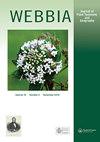Pollen analysis of some Burkina Faso honey samples
Q3 Agricultural and Biological Sciences
引用次数: 5
Abstract
ABSTRACT Palynological analyses were carried out on 12 honey samples, with the aim of identifying the plants foraged by honeybee populations in six provinces of Burkina Faso. A total of 46 different pollen grains were identified at the species level, and 29 botanical families were reported. In the honey samples, the Fabaceae were the most representative botanical family with more than 11 different species, corresponding to 24% of the all examined pollen grains. The other common families were, respectively: Malvaceae (11%), Rubiaceae (9%), Poaceae (7%) and Combretaceae (7%). At species and genus level, Piliostigma thonningii (Schum.) Milne-Redh. (42%), Combretum type and Acacia type (42%), were the most frequently bee-visited plants, followed by Cochlospermum planchonii Hook. f. (33%) and Mitracarpus scaber Zucc. (33%). A total of five honey samples were considered as unifloral, and were derived from the following species: Lannea microcarpa Engl., Vitellaria paradoxa C. F. Gaertn., Cassia mimosoides L. and genus Combretum Loefl. The other seven honey samples were not comprised of a predominant pollen type and may be considered multifloral. Within these last, Piliostigma thonningii, Grewia bicolor Juss. and Detarium microcarpum Guill. & Perr. were well represented. The polylectic behaviour of Apis mellifera adansonii Latreille and the heterogeneous sources of forage were confirmed.布基纳法索部分蜂蜜样品的花粉分析
摘要对布基纳法索6个省的12份蜂蜜样品进行了孢粉学分析,目的是鉴定蜜蜂种群觅食的植物。在种水平上共鉴定出46种不同的花粉粒,报告了29个植物科。在蜂蜜样品中,豆科是最具代表性的植物科,有超过11种不同的物种,占所有检测花粉粒的24%。其他常见科分别为:锦葵科(11%)、茜草科(9%)、豆科(7%)和combretacae科(7%)。在种属水平上,毛柱头(pilo柱头thonningii)Milne-Redh。蜜蜂最常光顾的植物是Combretum型和金合欢型(42%),其次是Cochlospermum planchonii Hook。f.(33%)和Mitracarpus scaber Zucc。(33%)。共5份蜂蜜样品被认为是单花的,它们来自以下物种:Lannea microcarpa Engl;;;;;;、蜜果决明子和龙葵属。其他7个蜂蜜样品的花粉类型不占优势,可以认为是多花的。在这些最后一种,毛蕊柱头thonningii,灰蔷薇双色Juss。和细木纹细木纹。&穗青葱。我们很有代表性。证实了美洲蜜蜂的聚电行为和饲料来源的异质性。
本文章由计算机程序翻译,如有差异,请以英文原文为准。
求助全文
约1分钟内获得全文
求助全文

 求助内容:
求助内容: 应助结果提醒方式:
应助结果提醒方式:


